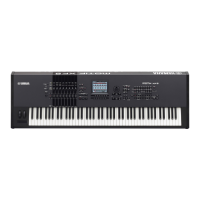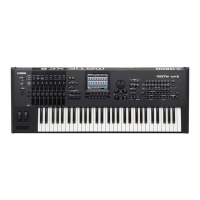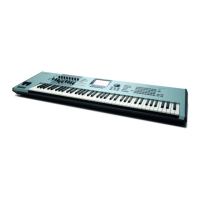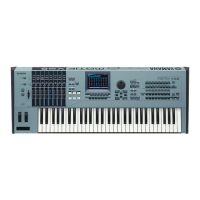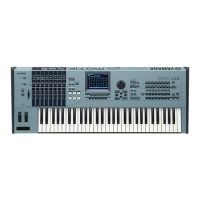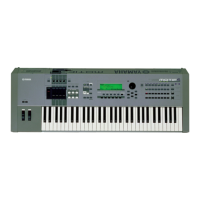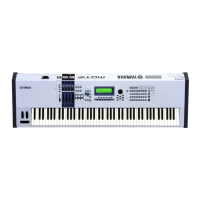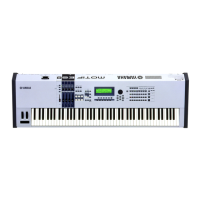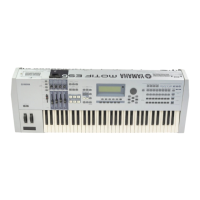
Do you have a question about the Yamaha MOTIF XF7 and is the answer not in the manual?
| Keyboard | 76 keys |
|---|---|
| Wave ROM | 741 MB (when converted to 16-bit linear format) |
| Normal Voices | 1, 024 |
| Reverb Types | 24 |
| Vocoder | Yes |
| Arpeggiator | Yes |
| MIDI | In/Out/Thru |
| USB | USB to Host, USB to Device |
| Type | Workstation Synthesizer |
| Polyphony | 128 voices |
| Sound Engine | AWM2 |
| Chorus Types | 22 |
| Master Effect Types | 9 |
| Sequencer | 16-track |
| Sequencer Note Capacity | Approx. 130, 000 notes |
| Arpeggiator Patterns | 1, 152 |
| Display | 320 x 240 dot backlit LCD |
| Connectivity | MIDI In/Out/Thru, USB |
| Storage | Flash Memory |
| Flash Memory | 128MB (Optional) |
| Effects | Reverb, Chorus, Insertion Effects, Master Effects, Vocoder |
Explains labels and graphics related to product safety on the enclosure.
Yamaha's commitment to user safety and environmental friendliness in product design.
Details on product testing, safety approvals, and modifications.
Yamaha reserves the right to change specifications without prior notice.
Identifies the location of the name plate containing model and serial number information.
Outlines major risks like electrical shock, fire, and damage, with specific warnings.
Details precautions to avoid physical injury or damage to the instrument and property.
Prohibits copying of commercially available musical data except for personal use.
Explains device optimization for music data and potential playback differences.
Clarifies that illustrations are for instructional purposes and may differ from the actual instrument.
Recommends checking the website for firmware updates and improvements.
Describes the expanded library of preset Voices covering various music styles.
Introduces a sophisticated tone generation system for realistic performance techniques.
Details the wide array of signal processing options, including Reverb, Chorus, and Insertion Effects.
Notes the improved design of the LCD display for easier viewing of information.
Highlights the addition of new Arpeggio types and the total count of available Arpeggios.
Mentions the 128 MB of built-in SDRAM for performing audio sampling.
Describes the option to install a module for storing sampled audio data even when power is off.
Details the types of keyboards used in MOTIF XF models and their touch response features.
Explains the capability to record performances as audio files and play back audio files.
Notes the seamless integration with Cubase for music production.
Identifies and explains the primary controls on the top panel, including keyboard and performance controllers.
Details controls for multi-part volume, Arpeggio, effects, and remote operation of DAW software.
Explains display elements, navigation buttons, data dial, and mode selection buttons.
Details buttons for common editing, category search, track control, mute, and solo functions.
Overview of rear panel ports including power, network, USB, digital audio, MIDI, and expansion slots.
Details audio outputs, inputs, headphone jack, footswitch/controller jacks, and gain control.
Instructions on connecting the AC power cord and warnings for proper usage.
Guidance on connecting external audio monitoring equipment like speakers or headphones.
Steps for safely turning on the instrument and connected audio devices.
How to adjust master volume and LCD contrast for optimal visibility and sound.
Instructions on how to play preset demo songs to experience the instrument's sound.
Steps to start, play, and stop the demo song using the SEQ TRANSPORT buttons.
Procedure to restore factory default demo songs and patterns, overwriting existing data.
How to restore the instrument's user memory to its original factory settings.
Explains how to navigate the display using the four cursor buttons.
Details how to change parameter values using the data dial and INC/YES/DEC/NO buttons.
Describes using buttons as a numeric keypad for direct value input.
Explains how to use F1-F6 and SF1-SF5 buttons to access functions and sub-functions.
Guide to naming data like Voices, Performances, Songs, and files using the character input window.
How to set key or velocity ranges for functions using keyboard input.
How to access pop-up lists for selecting parameter settings or items.
Play and create single Voices; also create original Voices.
Play and create Performances by layering or splitting Voices.
Register and recall often-used settings, and divide keyboard into Zones.
Record, edit, and play original Songs; use as multi-timbral tone generator.
Create, record, and play rhythm Patterns; use as multi-timbral tone generator.
Record audio signals like vocals or guitar as digital data for Samples.
Set parameters for multi-timbral tone generator for Song/Pattern playback.
Save/load data, record keyboard performance as audio, and play back audio files.
Set parameters that apply to the entire system of the instrument.
Distinguishes between pitched instrument sounds (Normal) and percussion sounds (Drum).
Explains the different types of Banks for memorizing Voices: Preset, User, and GM.
Step-by-step guide to selecting a Voice from the Preset Banks using buttons and displays.
Efficiently find and select Voices by category and sub-category.
How to trigger rhythm patterns and riffs by playing notes, and select Arpeggio types.
Settings to transmit Arpeggio phrases as MIDI data for external control.
How to adjust Arpeggio playback tempo using the Tap button.
Guide to assigning different Arpeggio types to the SF1-SF5 buttons.
Explains how to use Pitch Bend, Modulation Wheel, Ribbon Controller, and Assignable Function buttons.
How to utilize the eight knobs for real-time sound editing while playing.
Explains how to edit Voices, including Normal Voice, Drum Voice, Elements, and the Edit Indicator.
How to add and adjust effects like reverb and chorus to enhance Voices.
Steps to save edited Voices to internal memory, including selecting a destination.
How to select and load Performances, similar to selecting Voices.
Explains the information displayed in the Performance Play mode, including Part names and controller assignments.
Describes typical ways Performances are created by assigning Voices to up to four Parts.
How controllers and knobs affect sound in the Performance mode, similar to Voice mode.
Explains different ways to combine Voices in a Performance: Layer and Split by note range/velocity.
Guide to combining two Voices into a layer for a richer sound.
Steps to create an original Performance by combining existing Voices.
How to initialize a Performance to start creating a new one.
How to adjust the volume of individual Parts using the control sliders.
Guide to assigning different Arpeggio types and settings to individual Parts within a Performance.
How to save a created Performance to internal memory.
Explains how keyboard performance and Arpeggio playback are recorded to Song/Pattern tracks.
Step-by-step guide to recording keyboard performances with Arpeggios into a Song.
How to record Arpeggio performances into Patterns for use as building blocks in Songs.
Instructions for recording performances as WAV audio files to a USB device or computer.
How to play WAV and AIFF audio files stored on a USB device or networked computer.
How to assign and store settings for Voice, Performance, Song, or Pattern programs.
How to configure the keyboard into up to eight Zones for controlling multiple devices.
Steps to enter Zone Edit mode to configure parameters for individual Zones.
Defines key terms for song creation and explains track mute/solo functions for playback control.
How to adjust the volume for each Part using the panel sliders.
Step-by-step guide for setting up and performing realtime recording to a track.
How to record Arpeggio playback directly into a Song track.
Instructions on how to edit recorded MIDI events, notes, and gate times in the Song Edit mode.
How to apply a swing feel to recorded performances using Play Effect settings.
Using a Job operation to permanently apply Play Effect settings to Song MIDI data.
How to save the created Song to internal memory.
Explains the structure of Patterns, consisting of Sections (A-P) and tracks.
Encourages listening to preset demo Patterns for inspiration and ideas.
How to select a Pattern using the data dial.
How to navigate between Sections (A-P) using buttons.
How to create Patterns using the MOTIF XF's Arpeggio playback features.
How to view the assigned "Phrase" for each track within a Pattern Section.
How to arrange created Pattern Sections into a chain and convert it to Song data.
How to save the created Pattern to internal memory.
Steps to insert Sections (A, B, C, D) into specific measures of the Pattern Chain.
Process of converting a Pattern Chain into Song data for adding melody parts.
How to record melody parts over backing tracks converted from a Pattern Chain.
How to save the recorded Song to internal memory.
How to adjust parameters like Voice, volume, and pan for each Part in the Mixing display.
How to save the Mixing parameter settings for the Song or Pattern.
Steps to prepare the instrument for sampling, including connecting audio and setting gain.
How to sample audio and assign it to Waveforms and User Voices.
Detailed steps for sampling audio signals, setting recording parameters, and starting the process.
How to edit sampled audio by trimming, setting start/end points, and saving.
How to save the sampled Waveform to a USB storage device or Flash Memory Expansion Module.
How to record audio data for use in Patterns, including slicing audio into samples.
How to use the Slice function to divide recorded audio into segments and assign them to notes.
How to sample short audio sounds and integrate them into Songs.
Instructions for saving sampled Waveforms to the optional Flash Memory Expansion Module.
How to configure automatic tasks like loading files or entering specific modes upon power-on.
How to choose the visual design type for the top display in Voice, Performance, and Master modes.
Detailed steps to change display design type and name position for different modes.
How to adjust the instrument's overall tuning to match other instruments.
How to transpose the keyboard's pitch up or down in semitones or octaves.
Instructions for connecting the MOTIF XF to a computer via USB for MIDI communication.
Explains MIDI data assignment across channels and ports for computer connectivity.
How to connect the MOTIF XF to a computer using an IEEE1394 cable for audio and MIDI data transfer.
Illustrates the flow of audio and MIDI signals when connecting via IEEE1394.
Details how the MOTIF XF receives audio signals via FW IN channels.
How to use the MOTIF XF as a tone generator for DAW software playback.
How to record MOTIF XF performances into a DAW for mixing and playback.
Configuration steps on the MOTIF XF for computer connectivity, including Local Control and MIDI settings.
How to connect and use external tone generators with the MOTIF XF.
How to use the MOTIF XF's A/D INPUT and IEEE1394 connectors as an audio interface for a computer.
How to control DAW software from the MOTIF XF's panel controls.
Lists compatible computer software like Cubase, SONAR, Logic Pro, and Digital Performer.
Steps to set up the MOTIF XF and DAW software for remote control functionality.
How to enter Remote Control mode and use panel controls to operate DAW software.
How to use the VST Editor for convenient editing of Voices and Mixing setups via computer.
Steps to save instrument data like Voice, Song, and Pattern to a USB storage device.
Steps to load instrument data from a USB storage device into the instrument.
Information on compatible USB devices, media formatting, and usage notices.
Lists and explains various messages that may appear on the LCD display during operation.
Continues the list of display messages and their meanings, covering operations like saving, password, and sample errors.
Troubleshooting steps for when no sound is produced, covering levels, connections, and settings.
Addresses issues like distorted sound from effects/filters and problems starting or stopping Arpeggios.
Troubleshooting for filter-related distortion, clipping from high volume, and sound cutoff due to polyphony limits.
Solutions for issues where only one note sounds (mono mode) or pitch/intervals are incorrect.
Troubleshooting for Arpeggio not starting/stopping, and performance sounds differing from Voice mode.
Checks for issues preventing Song/Pattern playback, including remote control and MIDI sync settings.
Troubleshooting for problems with Song/Pattern recording, sample recording, and microphone function.
Addresses problems with data communication via MIDI, USB, or IEEE1394 between computer and MOTIF XF.
Troubleshooting for network connectivity problems, password issues, and MIDI bulk data transmission.
Solutions for problems saving data to external USB storage devices, including formatting and write-protection.
Lists optional devices like the FW16E FireWire board and Flash Memory Expansion Modules.
Shows where the optional hardware can be installed on different MOTIF XF models.
Important safety and handling precautions before and during hardware installation.
Step-by-step instructions for installing the FW16E FireWire expansion board.
Details the memory sizes and slot configurations for Flash Memory Expansion Modules.
Steps for installing the Flash Memory Expansion Modules, including preparing the unit and attaching the modules.
Detailed guide for inserting and securing the Flash Memory Modules into the slots.
Instructions on how to safely remove the installed Flash Memory Modules.
Technical specifications for keyboards, polyphony, and tone generator features.
Specifications for waveform memory, Voices, Performances, and sampling capabilities.
Details on sequencer capacity, tempo, recording types, tracks, patterns, phrases, and songs.
Specifications for Arpeggio types, scene memory, and sequence formats.
Specifications for Master mode, controllers, display, connectors, and power consumption.
Physical dimensions, weight, and included accessories for the MOTIF XF.
Information regarding the availability and terms of source code distribution under GNU GPL.
